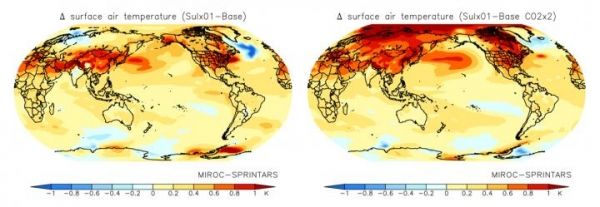As countries around the world race to mitigate global warming by limiting carbon dioxide emissions, an unlikely source could be making climate goals harder to achieve without even deeper cuts in greenhouse gas production: reductions in air pollution.
New modeling experiments from Kyushu University in Japan of the long-term effects of reductions in pollutants known as sulfate aerosols predicts further increases in surface air temperature at current and increased carbon dioxide levels because of the loss of an overall cooling effect caused by the light-scattering particles.
“Air pollution causes an estimated seven million premature deaths per year worldwide, so action is essential, especially in emerging and developing countries, which tend to be most affected,” says Toshihiko Takemura, professor at Kyushu University’s Research Institute for Applied Mechanics and author of the study.
Read more at: Kyushu University
Simulations using MIROC-SPRINTARS predict annual mean distribution of changes in surface air temperature following reduction of SO2 emissions from fuel sources to 10% of the current level under present (left) and doubled (right) CO2 concentrations. Decreasing sulfate aerosols from human activity at high CO2 concentrations results in enhanced temperature increases, especially in the mid-to-high latitudes of the Northern Hemisphere. (Photo Credit: Toshihiko Takemura, Kyushu University)


